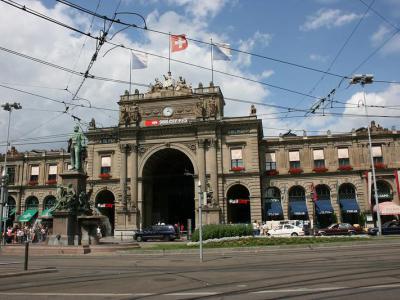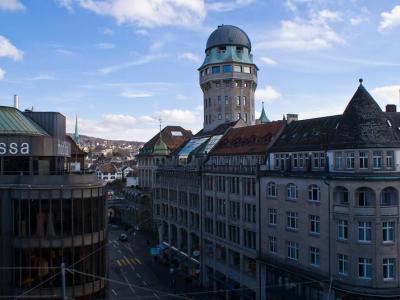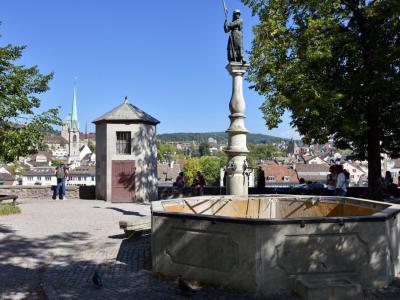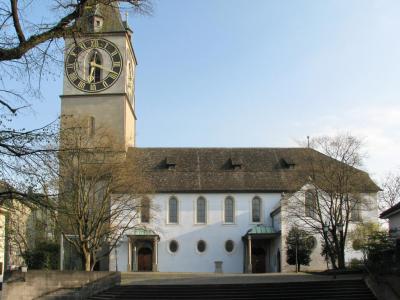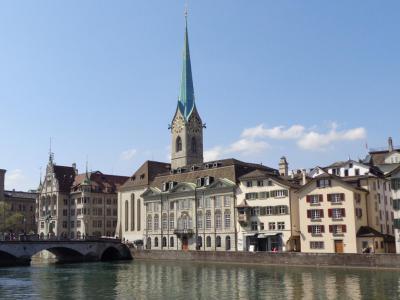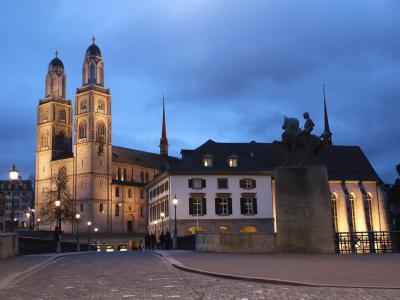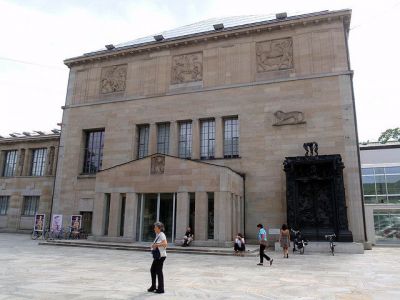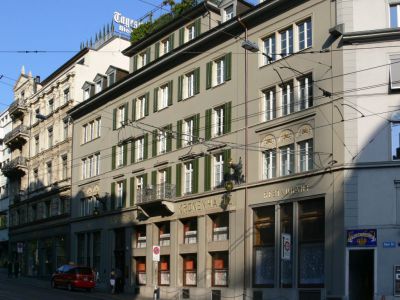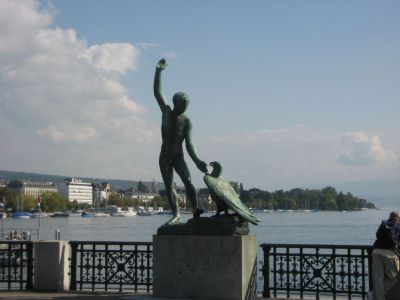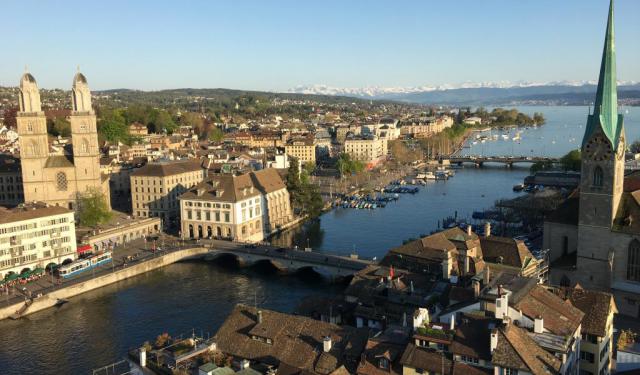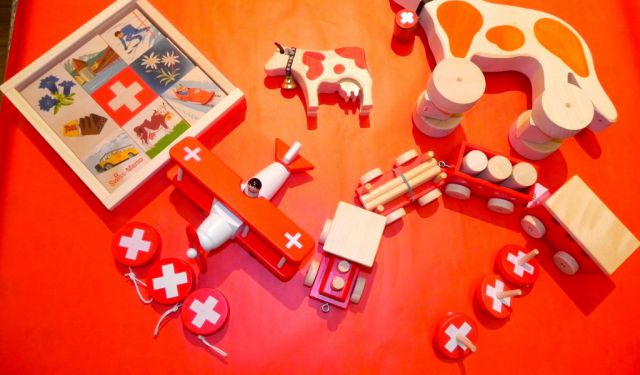Audio Guide: Zurich Introduction Walking Tour (Self Guided), Zurich
Zurich-Switzerland’s largest city and possibly the classiest time machine you’ll ever stroll through. Beneath its polished surface of banks, trams, and world-class chocolate lies a city with roots older than most empires. Humans have been hanging out here for over 6,000 years, and in 15 BC the Romans finally gave it a name: Turicum-meaning “the place of Turos”, likely stemming from a Gaulish personal name, Turos-because even back then, people loved naming places after themselves...
Over time, Zurich grew from a Roman customs post to a powerful Free Imperial City in the Middle Ages, and later, in the 16th century, became a centre of the Protestant Reformation led by one Ulrich Zwingli-kind of like Switzerland’s answer to Martin Luther, but with a sleeker font...
These days, Zurich is a mash-up of history and high finance. It’s the home base of banking behemoths like UBS and Credit Suisse, and thanks to Zurich Central Railway Station-one of the busiest railway stations in Europe-it is also where many adventures begin. Step outside the station and voilà, you’re on Station Street: the one where your wallet might panic but your eyes will thank you.
For a respite from all things mercantile, gaze at the stars from Urania Observatory, which has been open since 1907 and is proof that even bankers need to dream. Or head uphill to Lindenhof Square, once a Roman fort, now the perfect place to sit under lime trees and wonder where all your francs have gone...
When it comes to churches, Zurich doesn’t hold back. St. Peter's Church boasts Europe’s largest clock face-because punctuality is practically practically the country's second religion. The Church of Our Lady dazzles with stained glass by Marc Chagall and once housed noblewomen who probably judged your posture. Across the river stands the Great Minster, a twin-towered titan where Zwingli shook up the Swiss religious scene.
Art buffs, rejoice: the Art Museum of Zurich is bursting with masterpieces, from Giacometti’s spindly figures to heavy hitters like Van Gogh and Picasso. And when it’s time to dine, Kronenhalle restaurant is an edible art gallery where your schnitzel comes with a side of Miró.
End your stroll at Burkli Square by the lake, where boats bob, markets buzz, and Zurich breathes a little deeper.
So, slip on your comfy shoes, open up your mind (and maybe your wallet), and let Zurich surprise you-because this city is full of stories just waiting to be walked into.
Over time, Zurich grew from a Roman customs post to a powerful Free Imperial City in the Middle Ages, and later, in the 16th century, became a centre of the Protestant Reformation led by one Ulrich Zwingli-kind of like Switzerland’s answer to Martin Luther, but with a sleeker font...
These days, Zurich is a mash-up of history and high finance. It’s the home base of banking behemoths like UBS and Credit Suisse, and thanks to Zurich Central Railway Station-one of the busiest railway stations in Europe-it is also where many adventures begin. Step outside the station and voilà, you’re on Station Street: the one where your wallet might panic but your eyes will thank you.
For a respite from all things mercantile, gaze at the stars from Urania Observatory, which has been open since 1907 and is proof that even bankers need to dream. Or head uphill to Lindenhof Square, once a Roman fort, now the perfect place to sit under lime trees and wonder where all your francs have gone...
When it comes to churches, Zurich doesn’t hold back. St. Peter's Church boasts Europe’s largest clock face-because punctuality is practically practically the country's second religion. The Church of Our Lady dazzles with stained glass by Marc Chagall and once housed noblewomen who probably judged your posture. Across the river stands the Great Minster, a twin-towered titan where Zwingli shook up the Swiss religious scene.
Art buffs, rejoice: the Art Museum of Zurich is bursting with masterpieces, from Giacometti’s spindly figures to heavy hitters like Van Gogh and Picasso. And when it’s time to dine, Kronenhalle restaurant is an edible art gallery where your schnitzel comes with a side of Miró.
End your stroll at Burkli Square by the lake, where boats bob, markets buzz, and Zurich breathes a little deeper.
So, slip on your comfy shoes, open up your mind (and maybe your wallet), and let Zurich surprise you-because this city is full of stories just waiting to be walked into.
How it works: Download the app "GPSmyCity: Walks in 1K+ Cities" from Apple App Store or Google Play Store to your mobile phone or tablet. The app turns your mobile device into a personal tour guide and its built-in GPS navigation functions guide you from one tour stop to next. The app works offline, so no data plan is needed when traveling abroad.
Zurich Introduction Walking Tour Map
Guide Name: Zurich Introduction Walking Tour
Guide Location: Switzerland » Zurich (See other walking tours in Zurich)
Guide Type: Self-guided Walking Tour (Sightseeing)
# of Attractions: 10
Tour Duration: 2 Hour(s)
Travel Distance: 2.9 Km or 1.8 Miles
Author: ellen
Sight(s) Featured in This Guide:
Guide Location: Switzerland » Zurich (See other walking tours in Zurich)
Guide Type: Self-guided Walking Tour (Sightseeing)
# of Attractions: 10
Tour Duration: 2 Hour(s)
Travel Distance: 2.9 Km or 1.8 Miles
Author: ellen
Sight(s) Featured in This Guide:
- Zurich Hauptbahnhof (Central Railway Station)
- Bahnhofstrasse (Station Street)
- Urania Observatory
- Lindenhofplatz (Lindenhof Square)
- St. Peterskirche (St. Peter's Church)
- Fraumünster (Church of Our Lady)
- Grossmünster (Great Minster)
- Kunsthaus Zurich (Museum of Art)
- Kronenhalle Restaurant
- Bürkliplatz (Burkli Square)
1) Zurich Hauptbahnhof (Central Railway Station)
Known to locals and rail nerds alike as Zurich HB, this train station is Switzerland’s largest and possibly its busiest overachiever. Thanks to Zurich’s prime perch in the heart of Europe, HB has long been the continent’s commuter magnet, currently juggling over 2,000 trains a day like it’s just another Tuesday.
Nestled between the charming wrinkles of the Old Town and flanked by the Limmat and Sihl Rivers, this station even has a river running under it. Yes, the Sihl cruises through a tunnel beneath the platforms like it’s got a ticket too. And speaking of platforms, Zurich HB runs on two levels-one up top, one down below-with a fully functional shopping mall called ShopVille connecting the two.
The station’s railway roots go back to 1847, when the very first Zurich terminal linked to Baden via the Swiss Northern Railway. But as train traffic multiplied like clockwork, the city had to go big. The grand 1871 upgrade produced a neo-Renaissance beauty with soaring arches, stylish lobbies, and even a statue out front of Alfred Escher, the man who made Swiss trains cool before it was cool.
Modern tweaks followed: electrified lines in the early 1900s, computer-controlled signals in the 60s-because even old souls need fresh software. Today, Zurich HB is more than a transit point; it’s a full-blown railway cathedral with shopping, history, and a river casually flowing underneath. All aboard!
Nestled between the charming wrinkles of the Old Town and flanked by the Limmat and Sihl Rivers, this station even has a river running under it. Yes, the Sihl cruises through a tunnel beneath the platforms like it’s got a ticket too. And speaking of platforms, Zurich HB runs on two levels-one up top, one down below-with a fully functional shopping mall called ShopVille connecting the two.
The station’s railway roots go back to 1847, when the very first Zurich terminal linked to Baden via the Swiss Northern Railway. But as train traffic multiplied like clockwork, the city had to go big. The grand 1871 upgrade produced a neo-Renaissance beauty with soaring arches, stylish lobbies, and even a statue out front of Alfred Escher, the man who made Swiss trains cool before it was cool.
Modern tweaks followed: electrified lines in the early 1900s, computer-controlled signals in the 60s-because even old souls need fresh software. Today, Zurich HB is more than a transit point; it’s a full-blown railway cathedral with shopping, history, and a river casually flowing underneath. All aboard!
2) Bahnhofstrasse (Station Street) (must see)
Stepping out of Zurich HB, you can't miss Station Street-Zurich’s grand catwalk for wallets with stamina and shoes built for cobblestone. This is the city’s main shopping artery, mostly reserved for pedestrians and trams, which means you’ll be dodging Gucci bags, not taxis. Lined with luxury boutiques and upscale restaurants, this is where Swiss precision meets retail therapy.
The stroll kicks off right outside the station, on Station Square, because Zurich doesn’t believe in metaphors when it comes to names. From there, Station Street marches south all the way to Lake Zurich, finishing at the ever-charming Burkli Square.
Along the way, you’ll saunter past Parade Square, the golden triangle of Swiss finance where the banks are so rich that even the pigeons have portfolios... This real estate is notoriously expensive, which is why the air here smells vaguely of money and truffle oil.
Fun fact: Station Street was born in the 1870s when Zurich’s medieval moats were filled in to make room for the modern city. In short, they replaced water defenses with window shopping-and honestly, that feels like progress.
In essence, Station Street is old Zurich’s nerve center. From here, charming streets like Rennweg and Augustinergasse twist off into postcard-perfect scenes, packed with shops, cafés, and just enough historical flair to justify your souvenir splurge.
If you need a break from luxury price tags, dive into ShopVille, the underground mall beneath the train station. It's got food, gifts, and treats for mere mortals-plus it's open on Sundays, unlike most of Zurich.
So, whenever you're in Zurich and feel like buying, browsing, or just people-watching with a pastry in hand, Station Street-the most stylish stampede of trams and shoppers in Switzerland-can deliver all of this.
Pro tips:
Trams are your best friend-so, hop on, hop off, and explore with the grace of a local who knows not to jaywalk. In winter, treat yourself to rooftop mulled wine and steaming hot chocolate. In summer, trade the boutiques for a lakeside stroll and watch the world glide by...
The stroll kicks off right outside the station, on Station Square, because Zurich doesn’t believe in metaphors when it comes to names. From there, Station Street marches south all the way to Lake Zurich, finishing at the ever-charming Burkli Square.
Along the way, you’ll saunter past Parade Square, the golden triangle of Swiss finance where the banks are so rich that even the pigeons have portfolios... This real estate is notoriously expensive, which is why the air here smells vaguely of money and truffle oil.
Fun fact: Station Street was born in the 1870s when Zurich’s medieval moats were filled in to make room for the modern city. In short, they replaced water defenses with window shopping-and honestly, that feels like progress.
In essence, Station Street is old Zurich’s nerve center. From here, charming streets like Rennweg and Augustinergasse twist off into postcard-perfect scenes, packed with shops, cafés, and just enough historical flair to justify your souvenir splurge.
If you need a break from luxury price tags, dive into ShopVille, the underground mall beneath the train station. It's got food, gifts, and treats for mere mortals-plus it's open on Sundays, unlike most of Zurich.
So, whenever you're in Zurich and feel like buying, browsing, or just people-watching with a pastry in hand, Station Street-the most stylish stampede of trams and shoppers in Switzerland-can deliver all of this.
Pro tips:
Trams are your best friend-so, hop on, hop off, and explore with the grace of a local who knows not to jaywalk. In winter, treat yourself to rooftop mulled wine and steaming hot chocolate. In summer, trade the boutiques for a lakeside stroll and watch the world glide by...
3) Urania Observatory
If you’ve ever dreamed of stargazing like an ancient Greek muse, look no further than the Urania Observatory-named, fittingly, after Urania, the celestial lady in charge of astronomy. This 50-meter (or 167-foot, if you're imperially inclined) tower pokes out above Zurich’s Old Town like a curious periscope aimed at the heavens. Construction kicked off in 1899, and by 1907, the public was officially invited to peer into the cosmos.
At the heart of the tower is a serious piece of optical wizardry: a Carl Zeiss refracting telescope with a two-lens system and a 600-times zoom that can make the moon look like it's ready for a selfie. The telescope stretches five meters long and rests on a vibration-proof pillar that goes straight through the building like a cosmic exclamation mark. Despite its age, it’s still a technical marvel-and yes, it got a full spa day in 2007 for its 100th birthday, courtesy of Carl Zeiss Co. in Germany.
But wait-this place isn’t just about interstellar eye candy. You’ll also get sweeping views of Zurich’s rooftops and skyline, which are particularly photogenic after sunset. Join a guided tour on a Friday or Saturday night, or time your visit with one of their special events throughout the year. And if all that stargazing stirs your appetite, don’t worry-they’ve got a bar and restaurant, too. Because sometimes nothing pairs with the rings of Saturn like a nice local beer...
At the heart of the tower is a serious piece of optical wizardry: a Carl Zeiss refracting telescope with a two-lens system and a 600-times zoom that can make the moon look like it's ready for a selfie. The telescope stretches five meters long and rests on a vibration-proof pillar that goes straight through the building like a cosmic exclamation mark. Despite its age, it’s still a technical marvel-and yes, it got a full spa day in 2007 for its 100th birthday, courtesy of Carl Zeiss Co. in Germany.
But wait-this place isn’t just about interstellar eye candy. You’ll also get sweeping views of Zurich’s rooftops and skyline, which are particularly photogenic after sunset. Join a guided tour on a Friday or Saturday night, or time your visit with one of their special events throughout the year. And if all that stargazing stirs your appetite, don’t worry-they’ve got a bar and restaurant, too. Because sometimes nothing pairs with the rings of Saturn like a nice local beer...
4) Lindenhofplatz (Lindenhof Square) (must see)
Perched above the Old Town of Zurich like a quiet, leafy crown, Lindenhof is both a park and a time machine with a view. And it's not just where the city began-it’s where the city still comes to breathe...
This peaceful hilltop was once the site of a Roman fortress, complete with ten towers and walls thick enough to make modern builders weep. The Romans got busy here in the 2nd century, but by the 9th, Louis the German decided the crumbling castle needed a royal facelift. Sadly, by the 13th century, the whole thing was abandoned, and locals did what locals do best-recycled the stones for new projects. Eco-friendly before it was cool...
And no, Zurich’s ancient swagger didn’t start with Roman togas and centurions. Long before Rome flexed its empire, Neolithic and Bronze Age folks had already claimed this hill as prime real estate. Back then, the Sihl River liked to flood the surrounding lands, and the elevated Lindenhof was the safe (and dry) bet.
Fast forward to the 1700s, and Lindenhof reinvented itself as a public park. The early crowd-pleaser, it was primarily about archery and crossbow contests that drew visitors in those days (indeed, nothing like a bit of target practice to go with your afternoon stroll...).
Nowadays, keep an eye out for the Hedwig Fountain, built in 1912 to honor one of Zurich’s boldest deceptions. During the 1292 siege by Duke Albert I, the city’s women donned full battle gear and manned the ramparts, while the men were off fighting elsewhere. The ruse worked, and Zurich lived to tell the tale. Today, Hedwig and her helmet still stand proudly in the park, thanks to sculptor Gustav Siber.
Apart from all the attractions inside, Lindenhof gives you panoramic eye-candy of Zurich’s rooftops, rivers, and lake-all in one relaxed snapshot. It’s the city’s breathing room, ideal for a pause between museum marathons and shopping sprees. Kids can run wild on the playgrounds, and for the tactically inclined, there’s an outdoor chessboard waiting to test your strategy.
Oh, and if you’re lucky, you might stumble onto a festival or event-just ask at the tourism office.
Insider tip:
Check out the replica of a Roman tombstone that first mentioned Turicum-Zurich’s name back when Latin was all the rage. The original is at the Swiss National Museum, but Lindenhof’s got its own copy for on-the-spot admiration...
This peaceful hilltop was once the site of a Roman fortress, complete with ten towers and walls thick enough to make modern builders weep. The Romans got busy here in the 2nd century, but by the 9th, Louis the German decided the crumbling castle needed a royal facelift. Sadly, by the 13th century, the whole thing was abandoned, and locals did what locals do best-recycled the stones for new projects. Eco-friendly before it was cool...
And no, Zurich’s ancient swagger didn’t start with Roman togas and centurions. Long before Rome flexed its empire, Neolithic and Bronze Age folks had already claimed this hill as prime real estate. Back then, the Sihl River liked to flood the surrounding lands, and the elevated Lindenhof was the safe (and dry) bet.
Fast forward to the 1700s, and Lindenhof reinvented itself as a public park. The early crowd-pleaser, it was primarily about archery and crossbow contests that drew visitors in those days (indeed, nothing like a bit of target practice to go with your afternoon stroll...).
Nowadays, keep an eye out for the Hedwig Fountain, built in 1912 to honor one of Zurich’s boldest deceptions. During the 1292 siege by Duke Albert I, the city’s women donned full battle gear and manned the ramparts, while the men were off fighting elsewhere. The ruse worked, and Zurich lived to tell the tale. Today, Hedwig and her helmet still stand proudly in the park, thanks to sculptor Gustav Siber.
Apart from all the attractions inside, Lindenhof gives you panoramic eye-candy of Zurich’s rooftops, rivers, and lake-all in one relaxed snapshot. It’s the city’s breathing room, ideal for a pause between museum marathons and shopping sprees. Kids can run wild on the playgrounds, and for the tactically inclined, there’s an outdoor chessboard waiting to test your strategy.
Oh, and if you’re lucky, you might stumble onto a festival or event-just ask at the tourism office.
Insider tip:
Check out the replica of a Roman tombstone that first mentioned Turicum-Zurich’s name back when Latin was all the rage. The original is at the Swiss National Museum, but Lindenhof’s got its own copy for on-the-spot admiration...
5) St. Peterskirche (St. Peter's Church) (must see)
Saint Peter's Church-Zurich’s oldest temple-is also, quite possibly, the city’s most punctual landmark. Built in the 9th century, this beauty has seen more centuries than your local pub’s clock has seen beers. And speaking of clocks, St. Peter’s claims the biggest clock face in all of Europe. At a whopping 8.6 meters in diameter, its minute hand alone is longer than most compact cars. No excuse for being late around here...
The church got some facelifts over the years-first in the 13th century and again in the 1700s-because, indeed, medieval landmarks deserve a little renovation every now and then. Until 1911, a firewatcher lived in the steeple, popping his head out the window four times an hour to scan for smoke. If flames were spotted, he’d wave a flag in the direction of the danger-simple, low-tech, and surprisingly effective. Thus, unlike many of its European cousins, Zurich avoided catastrophic fires. It turns out that medieval flag signals are not just for parades...
Inside the church, you’ll find a Baroque nave paired with a Romanesque choir-like architectural speed dating through the centuries. Look closely at the faded murals, and you might spot a saint lurking in the shadows. Above the pulpit, the name of God appears in Hebrew, a nod to the Reformation’s love for the Bible’s original languages. Think of it as ancient theological street cred...
Now here’s the kicker: Saint Peter’s Church has shared custody. The City of Zurich owns the tower, while the Swiss Reformed Church parish holds the rights to the bells, the belfry, and the staircase. It is, indeed, church co-parenting at its finest...
Tip for the savvy traveler: Admire it up close, but for peak Instagram potential, cross the river-the church is even prettier from a distance.
The church got some facelifts over the years-first in the 13th century and again in the 1700s-because, indeed, medieval landmarks deserve a little renovation every now and then. Until 1911, a firewatcher lived in the steeple, popping his head out the window four times an hour to scan for smoke. If flames were spotted, he’d wave a flag in the direction of the danger-simple, low-tech, and surprisingly effective. Thus, unlike many of its European cousins, Zurich avoided catastrophic fires. It turns out that medieval flag signals are not just for parades...
Inside the church, you’ll find a Baroque nave paired with a Romanesque choir-like architectural speed dating through the centuries. Look closely at the faded murals, and you might spot a saint lurking in the shadows. Above the pulpit, the name of God appears in Hebrew, a nod to the Reformation’s love for the Bible’s original languages. Think of it as ancient theological street cred...
Now here’s the kicker: Saint Peter’s Church has shared custody. The City of Zurich owns the tower, while the Swiss Reformed Church parish holds the rights to the bells, the belfry, and the staircase. It is, indeed, church co-parenting at its finest...
Tip for the savvy traveler: Admire it up close, but for peak Instagram potential, cross the river-the church is even prettier from a distance.
6) Fraumünster (Church of Our Lady) (must see)
The Church of Our Lady-or Fraumünster if you're feeling Swiss about it-is easily one of Zurich’s most eye-catching landmarks, thanks to that graceful blue spire that insists on being in every skyline photo. Founded way back in 853 by Emperor Louis the German for his daughter Hildegard (talk about a royal housewarming gift), this wasn’t an average cloistered convent. No, the abbess here wasn’t just praying and gardening-she was running the show. In medieval Zurich, she held market rights, minted coins, and had a firm grip on city affairs. Basically, before Zurich was ruled by bankers in suits, it was partly governed by nuns with serious executive power.
By 874, they’d added a basilica complete with a crypt that now houses Zurich’s patron saints, Felix and Regula-because a great city can certainly benefit from a couple of martyred siblings watching over it. But the good times for the abbey came to an end in 1524 during the Reformation. The last abbess handed the keys over to the city, and most of the religious art was either taken down or..., well, aggressively removed.
Today, people come not just for the medieval intrigue, but for the stunning mashup of Gothic architecture and Baroque flair. And then-boom-the stained glass. In the 1970s, none other than Marc Chagall himself stepped in and created five towering windows for the choir. Each one tells a biblical story in bold, glowing color. The “Prophet” window is all reds and oranges and righteous fire. Across from it are “Jacob,” “Christ,” and “Zion” in cooler, gentler hues, and the “Law” window fit to impress even Moses himself.
Also remarkable is the vibrant window near the entrance by Augusto Giacometti, adding another layer of artistic prestige to the church’s interior. So now it doubles as an accidental art museum.
If you're visiting, do grab the audio guide-it’s included with the ticket and actually quite good. You’ll get the full story, minus the Latin. Entry fees vary, and remember: while photos of the interior are generally allowed, pictures of the Chagall windows are strictly prohibited. Your phone will be tempted, but resist. Oh, and be sure to bring some Swiss francs, too-they still like their cash here.
So, whether you’re into saints, stained glass, or just need a break from the Station Street, the Church of Our Lady is a peaceful detour into Zurich’s soul-with a splash of color and a whole lot of history.
By 874, they’d added a basilica complete with a crypt that now houses Zurich’s patron saints, Felix and Regula-because a great city can certainly benefit from a couple of martyred siblings watching over it. But the good times for the abbey came to an end in 1524 during the Reformation. The last abbess handed the keys over to the city, and most of the religious art was either taken down or..., well, aggressively removed.
Today, people come not just for the medieval intrigue, but for the stunning mashup of Gothic architecture and Baroque flair. And then-boom-the stained glass. In the 1970s, none other than Marc Chagall himself stepped in and created five towering windows for the choir. Each one tells a biblical story in bold, glowing color. The “Prophet” window is all reds and oranges and righteous fire. Across from it are “Jacob,” “Christ,” and “Zion” in cooler, gentler hues, and the “Law” window fit to impress even Moses himself.
Also remarkable is the vibrant window near the entrance by Augusto Giacometti, adding another layer of artistic prestige to the church’s interior. So now it doubles as an accidental art museum.
If you're visiting, do grab the audio guide-it’s included with the ticket and actually quite good. You’ll get the full story, minus the Latin. Entry fees vary, and remember: while photos of the interior are generally allowed, pictures of the Chagall windows are strictly prohibited. Your phone will be tempted, but resist. Oh, and be sure to bring some Swiss francs, too-they still like their cash here.
So, whether you’re into saints, stained glass, or just need a break from the Station Street, the Church of Our Lady is a peaceful detour into Zurich’s soul-with a splash of color and a whole lot of history.
7) Grossmünster (Great Minster) (must see)
Now, if Zurich’s skyline had a king of the hill, it would probably be the Great Minster-standing tall, proud, and unmistakably Romanesque. It’s one of the city’s four major churches, rubbing historic shoulders with The Church of Our Lady, Preacher's Church, and Saint Peter's Church. But this one’s got some serious theological swagger.
Legend credits none other than Emperor Charlemagne-yes, that Charles the Great-with commissioning the place. Construction kicked off around 1100, and after about 120 years of medieval bricklaying, the Great Minster was born.
But here’s where it gets spicy: in the early 1500s, this church didn’t just host sermons-it became ground zero for the Swiss-German Reformation. Huldrych Zwingli, local priest and full-time disruptor, began preaching bold new ideas in 1520. By 1523, after winning a couple of intense theological debates, Zurich officially seceded from the Pope.
Zwingli’s influence ran deep. In 1524, the interior of the Great Minster underwent a makeover-with religious imagery, altars, and even the organ stripped away. Fasting was declared optional. Mass got rewritten. Celibacy-rethought. Church music? Well… eventually it made a comeback. What’s left is a beautifully bare, historically loaded space that tells the story of faith meeting reform head-on.
And speaking of Charles the Great, you’ll spot him again as a statue perched on the southern tower-sword in hand, crown slipping stylishly off his head like a medieval mic drop. The man unified a good chunk of Europe and even lent his name to the word “king” in many languages. Not bad for a guy in stone.
Okay, the church may seem a little plain inside-but don’t let that fool you. The stained-glass windows made from sliced agate are pure magic. The Carolus Magnus statue is iconic. And the front door alone could earn its own Instagram account.
Tip:
Feeling ambitious? Climb the tower-just 180+ steps up. No lift, no turning back. But once you’re up there, the views of Zurich are unbeatable, and best of all, you can catch your breath for as long as you like.
Legend credits none other than Emperor Charlemagne-yes, that Charles the Great-with commissioning the place. Construction kicked off around 1100, and after about 120 years of medieval bricklaying, the Great Minster was born.
But here’s where it gets spicy: in the early 1500s, this church didn’t just host sermons-it became ground zero for the Swiss-German Reformation. Huldrych Zwingli, local priest and full-time disruptor, began preaching bold new ideas in 1520. By 1523, after winning a couple of intense theological debates, Zurich officially seceded from the Pope.
Zwingli’s influence ran deep. In 1524, the interior of the Great Minster underwent a makeover-with religious imagery, altars, and even the organ stripped away. Fasting was declared optional. Mass got rewritten. Celibacy-rethought. Church music? Well… eventually it made a comeback. What’s left is a beautifully bare, historically loaded space that tells the story of faith meeting reform head-on.
And speaking of Charles the Great, you’ll spot him again as a statue perched on the southern tower-sword in hand, crown slipping stylishly off his head like a medieval mic drop. The man unified a good chunk of Europe and even lent his name to the word “king” in many languages. Not bad for a guy in stone.
Okay, the church may seem a little plain inside-but don’t let that fool you. The stained-glass windows made from sliced agate are pure magic. The Carolus Magnus statue is iconic. And the front door alone could earn its own Instagram account.
Tip:
Feeling ambitious? Climb the tower-just 180+ steps up. No lift, no turning back. But once you’re up there, the views of Zurich are unbeatable, and best of all, you can catch your breath for as long as you like.
8) Kunsthaus Zurich (Museum of Art) (must see)
The Art Museum of Zürich-one of Europe’s finest museums-is a full-blown visual feast for anyone who enjoys a bit of brain-tickling beauty.
Inside, the collection stretches from medieval mysticism to present-day punch, with Swiss art taking center stage. You’ll spot homegrown legends like Johann Heinrich Füssli-an author of the nightmarish horses-alongside Hodler’s bold forms, Pipilotti Rist’s audiovisual candy, and the cheeky duo Fischli & Weiss. But don’t worry, it’s not all Swiss: Edvard Munch broods on the walls too, while Vincent Van Gogh swirls away, Pablo Picasso throws shapes, and Alberto Giacometti’s spindly figures lurk around like stylish ghosts. Oh, and if you’re into soft lighting and lily pads, yes, Claude Monet and Marc Chagall are here too.
The museum leans into Swissness with flair: special collections highlight Swiss Realism, Zurich Concrete Art (yes, that's a thing), and the lush landscapes and symbolist dreams of Böcklin, Segantini, Vallotton, and again, our friend Hodler. Indeed, it’s got brains and beauty rolled into one.
And let’s not forget the video art section, which started in 1979-back when VHS was cutting-edge and artists decided TV wasn’t just for weather reports. You’ll find works by the likes of Acconci, Baldessari, Marclay, Paik, and other titans of the medium who turned screens into canvases.
There's more: rotating exhibitions keep things fresh, and there’s a library if you're the type who likes your art with a side of theory. The audio guide covers over 200 pieces-perfect if you enjoy having a knowledgeable voice in your ear that isn’t just your own...
Overall, the place is clever, bold, and unapologetically artsy-just like your most interesting friend. If modern art, surrealism, or impressionism make your heart race (or at least mildly speed up), you’ll feel right at home.
Tip:
Wednesdays offer free entry to the main collection. The audio guide is also free.
The building looks modest from the outside, but don’t be fooled-it’s a cultural TARDIS (a fictional hybrid of a time machine and spacecraft from the “Doctor Who” science fiction TV series).
Allow at least two to three hours. Your brain will thank you later.
Inside, the collection stretches from medieval mysticism to present-day punch, with Swiss art taking center stage. You’ll spot homegrown legends like Johann Heinrich Füssli-an author of the nightmarish horses-alongside Hodler’s bold forms, Pipilotti Rist’s audiovisual candy, and the cheeky duo Fischli & Weiss. But don’t worry, it’s not all Swiss: Edvard Munch broods on the walls too, while Vincent Van Gogh swirls away, Pablo Picasso throws shapes, and Alberto Giacometti’s spindly figures lurk around like stylish ghosts. Oh, and if you’re into soft lighting and lily pads, yes, Claude Monet and Marc Chagall are here too.
The museum leans into Swissness with flair: special collections highlight Swiss Realism, Zurich Concrete Art (yes, that's a thing), and the lush landscapes and symbolist dreams of Böcklin, Segantini, Vallotton, and again, our friend Hodler. Indeed, it’s got brains and beauty rolled into one.
And let’s not forget the video art section, which started in 1979-back when VHS was cutting-edge and artists decided TV wasn’t just for weather reports. You’ll find works by the likes of Acconci, Baldessari, Marclay, Paik, and other titans of the medium who turned screens into canvases.
There's more: rotating exhibitions keep things fresh, and there’s a library if you're the type who likes your art with a side of theory. The audio guide covers over 200 pieces-perfect if you enjoy having a knowledgeable voice in your ear that isn’t just your own...
Overall, the place is clever, bold, and unapologetically artsy-just like your most interesting friend. If modern art, surrealism, or impressionism make your heart race (or at least mildly speed up), you’ll feel right at home.
Tip:
Wednesdays offer free entry to the main collection. The audio guide is also free.
The building looks modest from the outside, but don’t be fooled-it’s a cultural TARDIS (a fictional hybrid of a time machine and spacecraft from the “Doctor Who” science fiction TV series).
Allow at least two to three hours. Your brain will thank you later.
9) Kronenhalle Restaurant
Tucked inside a stately building on Bellevue Square, which dates back to 1862, the Kronenhalle Restaurant is Zurich’s most famous dining room-a place where art, history, and a dash of old-world drama come together over veal and vintage wine. Opened in 1924 by the formidable Hulda and Gottlieb Zumsteg, it didn’t take long to become the unofficial clubhouse for writers, artists, and the culturally inclined. Ever since, Zurich’s elite-and those who dine like they are-have made it a regular haunt.
Indeed, dining here is like stepping into a Wes Anderson film set in the Alps: lush, elegant, and tastefully eccentric. The food is sublime. The service is practically choreographed. And the art? Oh, just a few pieces by Chagall, Miró, and Bonnard casually watching over your table while you attempt not to drop sauce on your lap...
The restaurant is split into three distinct galleries. In the brasserie, you’ll dine beneath chandeliers like a Swiss dignitary. The Chagall Room-cozier, quieter-was the original dining area and feels like a well-kept secret shared among bohemians and bon vivants. Then there’s the Swiss Gallery, a snug space celebrating homegrown art and Alpine refinement.
A word of warning: getting a table here isn’t easy. Think less walk-in, more orchestrated operation. Book weeks ahead or call in a favor from your hotel concierge-preferably the one who owes you...
Indeed, dining here is like stepping into a Wes Anderson film set in the Alps: lush, elegant, and tastefully eccentric. The food is sublime. The service is practically choreographed. And the art? Oh, just a few pieces by Chagall, Miró, and Bonnard casually watching over your table while you attempt not to drop sauce on your lap...
The restaurant is split into three distinct galleries. In the brasserie, you’ll dine beneath chandeliers like a Swiss dignitary. The Chagall Room-cozier, quieter-was the original dining area and feels like a well-kept secret shared among bohemians and bon vivants. Then there’s the Swiss Gallery, a snug space celebrating homegrown art and Alpine refinement.
A word of warning: getting a table here isn’t easy. Think less walk-in, more orchestrated operation. Book weeks ahead or call in a favor from your hotel concierge-preferably the one who owes you...
10) Bürkliplatz (Burkli Square)
Burkli-Zurich’s unofficial front porch, main square, and tram central all rolled into one. If you're looking for a place where the city gently slips off its shoes and enjoys the lake breeze, this is it. With a steady hum of trams passing through, it's where urban bustle meets lakeside leisure, and somehow, they get along quite nicely.
Just to the north, under the shade of well-behaved trees, is Stadthausanlage-a leafy square that hosts some of the city’s most delicious negotiations: veggies, cheese, flowers, and bread, all vying for your attention at the local market. In the middle, a classic music pavilion nods politely to passersby, often with a soundtrack to match.
From here, Station Street marches north like a well-dressed soldier, ready to lead you straight into Zurich’s high-end shopping world-credit cards beware...
But back to Burkli Square. It’s not just the transport hub or the snack stand heaven (though the bratwurst game is strong). It is also your launch pad for scenic lake cruises and water taxis-because, yes, Zurich knows how to do traffic with style.
To the east, the elegant Quay Bridge crosses the Limmat like a well-dressed Victorian gentleman. Nearby, the Seeuferanlage lakefront park stretches out invitingly, complete with an arboretum and aviary. Nature and relaxation? Yes, and yes.
And don't miss the statue of Ganymede at the lake overlook-it’s a dramatic bronze moment of myth-meets-modernity, with the young man being whisked away by Zeus’s eagle, as you do on an average Zurich afternoon...
Just a short stroll east, you'll run into the Geiserbrunnen, a beefy 1911 sculpture by Jakob Brüllmann, where a man appears to be in intense negotiation-or maybe just wrestling-with a bull. Either way, it's got the energy of a protein bar ad.
Burkli Square is not just a place to pass through-it’s a place to pause, snack, stare at some art, and maybe catch a boat. So, linger a little. Zurich doesn’t mind...
Just to the north, under the shade of well-behaved trees, is Stadthausanlage-a leafy square that hosts some of the city’s most delicious negotiations: veggies, cheese, flowers, and bread, all vying for your attention at the local market. In the middle, a classic music pavilion nods politely to passersby, often with a soundtrack to match.
From here, Station Street marches north like a well-dressed soldier, ready to lead you straight into Zurich’s high-end shopping world-credit cards beware...
But back to Burkli Square. It’s not just the transport hub or the snack stand heaven (though the bratwurst game is strong). It is also your launch pad for scenic lake cruises and water taxis-because, yes, Zurich knows how to do traffic with style.
To the east, the elegant Quay Bridge crosses the Limmat like a well-dressed Victorian gentleman. Nearby, the Seeuferanlage lakefront park stretches out invitingly, complete with an arboretum and aviary. Nature and relaxation? Yes, and yes.
And don't miss the statue of Ganymede at the lake overlook-it’s a dramatic bronze moment of myth-meets-modernity, with the young man being whisked away by Zeus’s eagle, as you do on an average Zurich afternoon...
Just a short stroll east, you'll run into the Geiserbrunnen, a beefy 1911 sculpture by Jakob Brüllmann, where a man appears to be in intense negotiation-or maybe just wrestling-with a bull. Either way, it's got the energy of a protein bar ad.
Burkli Square is not just a place to pass through-it’s a place to pause, snack, stare at some art, and maybe catch a boat. So, linger a little. Zurich doesn’t mind...
Walking Tours in Zurich, Switzerland
Create Your Own Walk in Zurich
Creating your own self-guided walk in Zurich is easy and fun. Choose the city attractions that you want to see and a walk route map will be created just for you. You can even set your hotel as the start point of the walk.
Zurich's Historical Churches Tour
The history of Christianity in Zurich is duly reflected in the local churches, found here in abundance. Indeed, Christianity has been the dominant religion of Zurich for many centuries. And while, historically, the city was a center of the Protestant Reformation, today it is home to both Catholic and Protestant communities.
The Swiss Reformed Church is the largest Protestant denomination, but... view more
Tour Duration: 1 Hour(s)
Travel Distance: 1.2 Km or 0.7 Miles
The Swiss Reformed Church is the largest Protestant denomination, but... view more
Tour Duration: 1 Hour(s)
Travel Distance: 1.2 Km or 0.7 Miles
Zurich Gourmet Tour
Apart from its high-quality watches, Switzerland is famous for its unique delicacies. The secrets of their making have been preserved for centuries and passed on from father to son. In this respect, it is not at all surprising that a global banking and financial center such as Zurich can be also a haven for food enthusiasts seeking gourmet delights. On this self-guided walk, we invite you to... view more
Tour Duration: 1 Hour(s)
Travel Distance: 2.1 Km or 1.3 Miles
Tour Duration: 1 Hour(s)
Travel Distance: 2.1 Km or 1.3 Miles
Old Town Walk
Zurich’s Old Town-the city’s historical core-is where the past shakes hands with charm and refuses to be boring. Spread on both sides of the Limmat River, this part of town still remembers when cobblestones were cutting-edge tech. They say “Zurich is a city, but Old Town is a village”-and yes, that pretty much nails it. A sort of medieval postcard with a side of espresso...
Old Town... view more
Tour Duration: 1 Hour(s)
Travel Distance: 1.4 Km or 0.9 Miles
Old Town... view more
Tour Duration: 1 Hour(s)
Travel Distance: 1.4 Km or 0.9 Miles
Zurich Souvenir Shopping
Zurich has no shortage of tourists, and when it comes to souvenirs, there are plenty of options available.
A popular saying goes, "When in Zurich, shop on Bahnhofstrasse." True, in terms of souvenir shopping, this thoroughfare is second to none. Another saying is that “When in Switzerland, buy Swiss-made products.”
Alongside many other things, Bahnhofstrasse is home to... view more
Tour Duration: 2 Hour(s)
Travel Distance: 2.5 Km or 1.6 Miles
A popular saying goes, "When in Zurich, shop on Bahnhofstrasse." True, in terms of souvenir shopping, this thoroughfare is second to none. Another saying is that “When in Switzerland, buy Swiss-made products.”
Alongside many other things, Bahnhofstrasse is home to... view more
Tour Duration: 2 Hour(s)
Travel Distance: 2.5 Km or 1.6 Miles
Useful Travel Guides for Planning Your Trip
15 Distinctively Swiss Things to Buy in Zurich
Zurich is Switzerland’s largest city, and although it may feel like a bustling metropolis, the tranquil essence of the Alps flows fervently through the lively cobblestone streets, the buzzing train station, and the frenzied designer boutiques. Most shops in downtown Zurich open at 9 am and close...
The Most Popular Cities
/ view all



